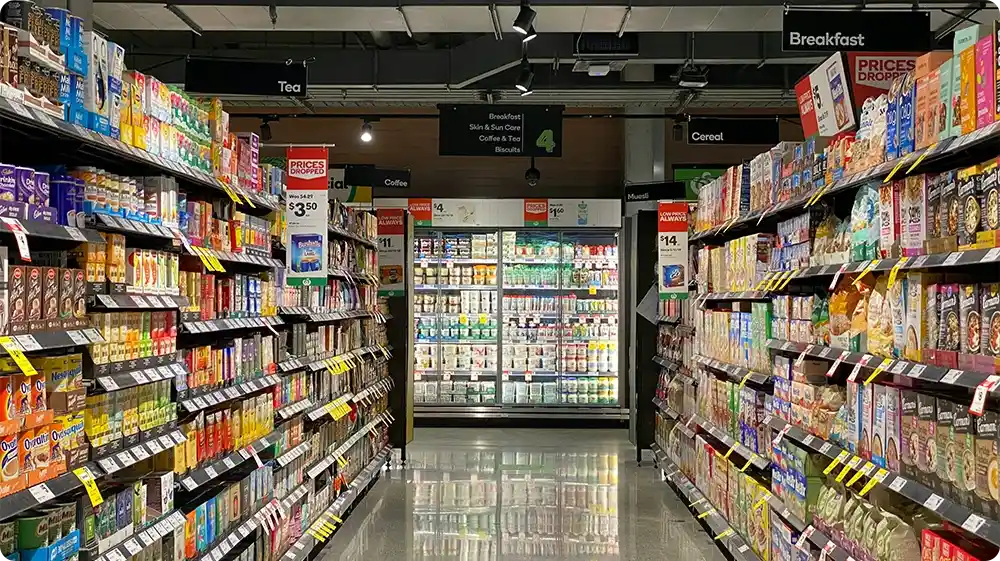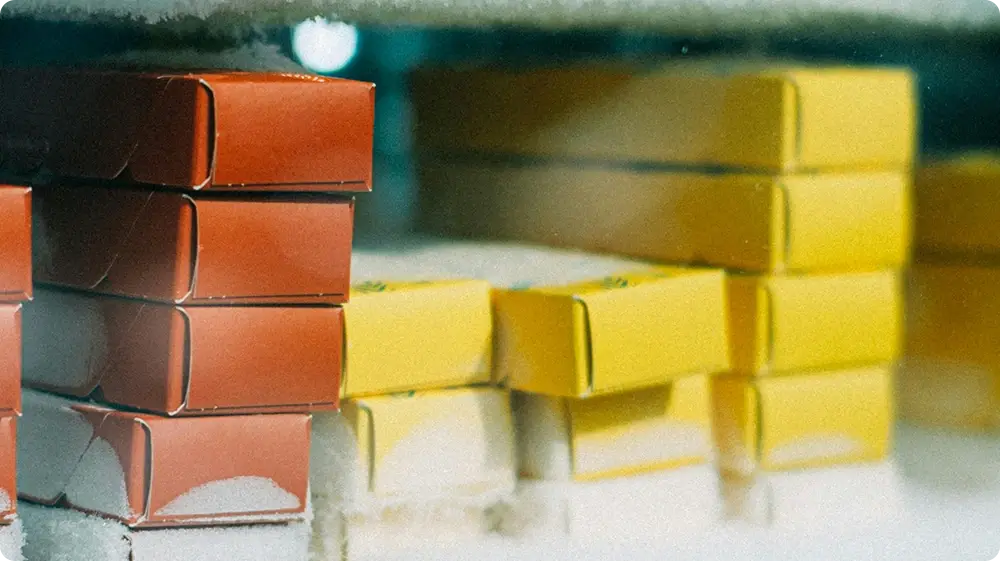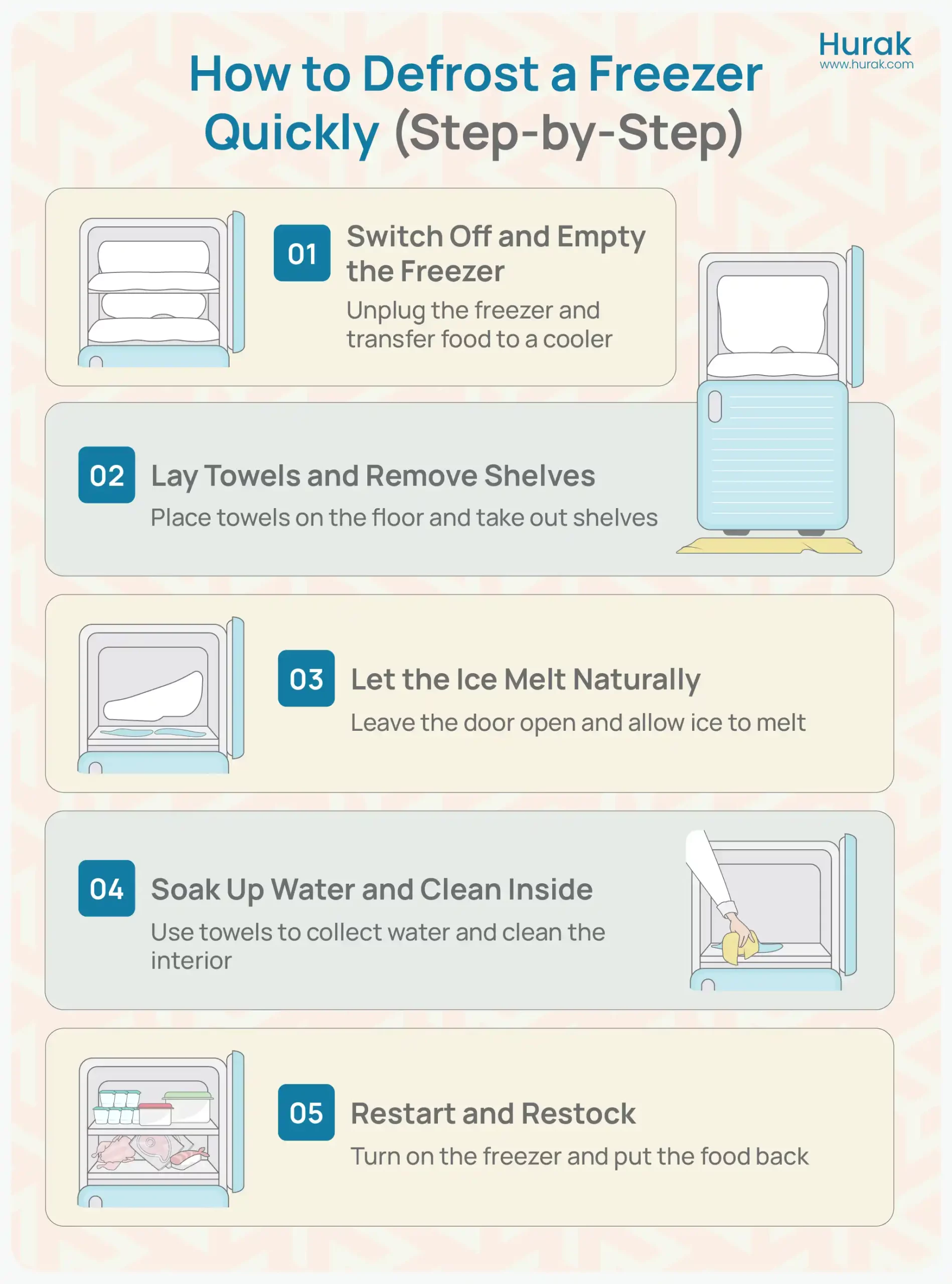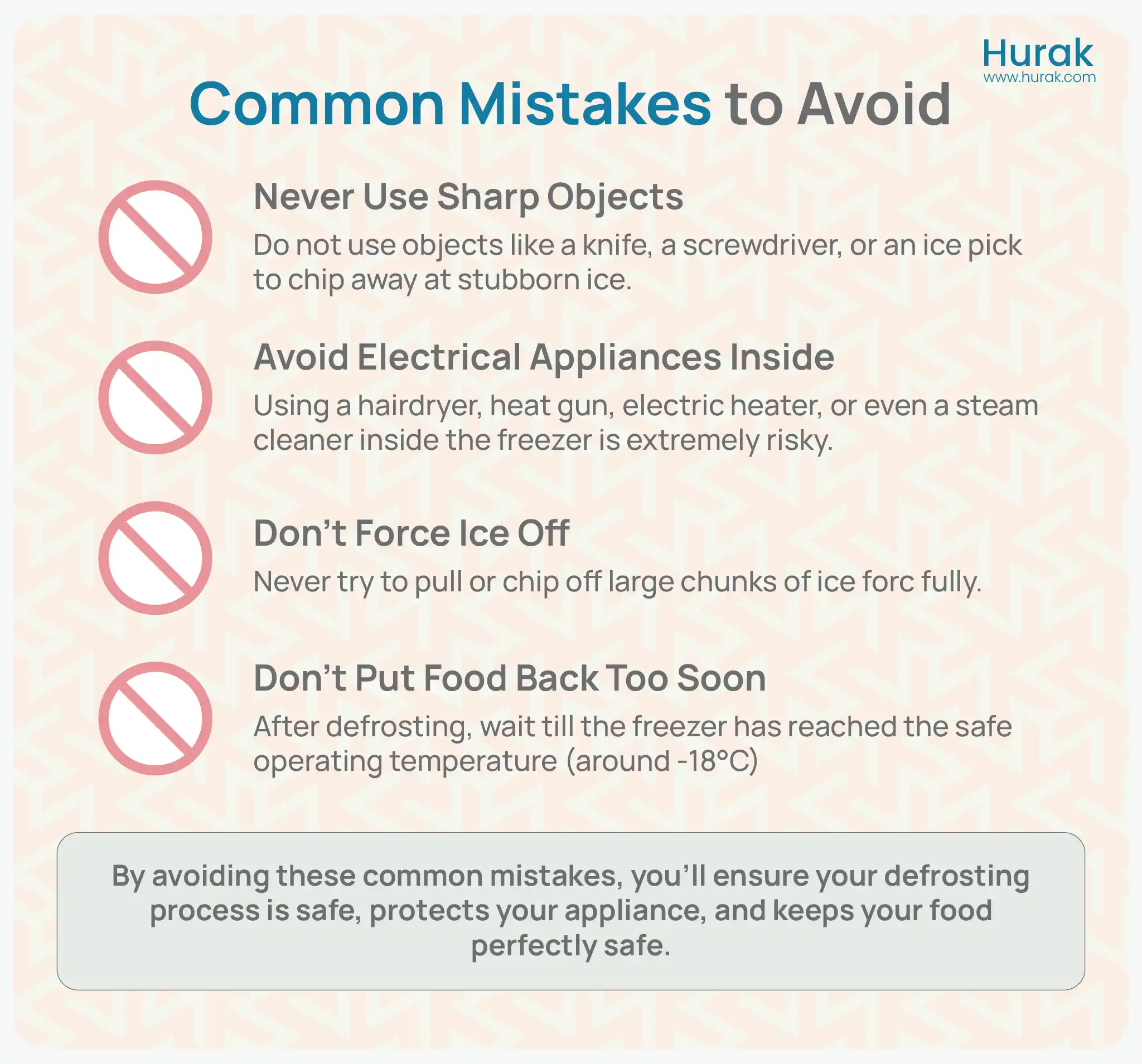Did you know that not defrosting your freezer can increase energy use by up to 30%, resulting in a significantly higher electricity bill?
Timely defrosting isn’t just about saving space—it’s also an effective way to cut energy costs and help your appliance run efficiently for longer.
According to AMDEA (the UK’s appliance manufacturers’ association), over 98% of UK homes own a fridge or fridge–freezer. Meanwhile, the Frozen Food Report 2021 by the British Frozen Food Federation (BFFF) reveals that Frozen food attracted over 400,000 new shoppers in the last two years.
With frozen food demand on the rise and new eateries opening daily, knowing how to defrost a freezer safely and efficiently is more crucial than ever.
A thick layer of ice doesn’t just take up valuable space—it can compromise food quality and reduce your freezer’s performance. Manual defrosting ensures proper food safety and helps protect your freezer from unnecessary strain.
In this article, we’ll walk you through everything you might wonder about defrosting a freezer, such as:
- How to defrost a freezer
- How often should you defrost it?
- How long does it take to defrost a freezer?
- What to do with food when defrosting the freezer?
We will answer all these and share some practical tips to streamline the task.

Why Defrosting Your Freezer Matters
As mentioned earlier, defrosting your freezer isn’t just about saving on energy bills; it plays a crucial role in maintaining your appliance’s performance. If you run a food business, timely defrosting of your freezer helps you comply with food hygiene regulations and maintain food safety standards.
Do you know the difference between Food Hygiene and Food Safety?
While they’re often used interchangeably, these two terms have distinct meanings, especially when it comes to food business compliance.
👉 Read our guide on the Difference Between Food Hygiene and Food Safety to get clarity and stay compliant.
Let’s understand the key pointers on why to defrost the freezer:
Improved Energy Efficiency
Each time you open your freezer, warm air enters and turns into frost. Over time, this frost builds up, particularly around the internal vents and coils, making it more difficult for the appliance to maintain cold temperatures.
As a result, the freezer operates at full capacity, consuming more energy than necessary.
Example:
Imagine trying to cool a room with the windows open—the same happens inside your freezer when frost blocks proper airflow. Defrosting helps your freezer run smoothly and keeps electricity bills in check.
Better Temperature Control
When ice builds up on the internal components, it can interfere with the freezer’s ability to maintain a consistent temperature.
This is particularly risky when storing meats, seafood, or dairy products, which require specific temperatures to remain safe.
According to the Food Standards Agency, frozen food should be stored at a temperature of -18˚C. Too much ice can push the internal temperature above this threshold, leading to food spoilage or safety breaches, especially in commercial kitchens.
Example:
If you run a café and your frozen chicken is stored at -14˚C instead of -18˚C due to frost build-up, you risk serving unsafe food.
That’s why it’s crucial to understand the basics of safe food storage temperature and how to organise a fridge, especially in a busy kitchen environment, so you can reduce the risk of cross-contamination and stay compliant with food safety standards.
More Space for Storage
Frost can occupy a surprising amount of space inside your freezer, limiting the amount of food you can store. This becomes a problem if you rely on freezer space for perishable stock, meal prep, or batch cooking.
Regular defrosting ensures you get maximum usable space, making it easier to store items properly and access them without having to dig through layers of ice.
Example:
A 100-litre freezer with thick ice on the walls can lose up to 10–15% of usable space. That’s the equivalent of losing room for a week’s worth of frozen meals.
Easier and More Effective Cleaning
A defrosted freezer is far easier to clean. Without ice getting in the way, you can wipe down the walls, shelves, and compartments more thoroughly, removing spills, odours, or residues that might otherwise go unnoticed.
Example:
If something like frozen spinach bursts or leaks during storage, you might not notice it under frost. Defrosting helps reveal hidden messes and maintain hygiene.
Opportunity to Organise and Take Stock
Defrosting gives you a perfect chance to review what you’ve stored, check expiry dates, and reorganise items.
This helps avoid unnecessary waste and ensures that older items are used before newer ones are introduced.
To know more about food expiry dates, read our article on the Difference Between Used By and Best Before Dates.
Example:
You might find a bag of frozen berries at the back that’s a year old, past its best quality. Defrosting days help you label, rotate, and keep things in order.
By regularly defrosting your freezer, you’re not only improving energy efficiency and creating more storage space, but you’re also taking an important step towards maintaining food quality, preventing waste, and ensuring compliance with safety standards.
Whether you’re running a food business or managing your home kitchen, this simple routine can make a big difference.
How Often Should You Defrost a Freezer?
If you have a freezer at home, defrosting it once a year is typically sufficient. However, in a commercial kitchen—such as a restaurant, café, or food truck—you should defrost it at least once every three months to comply with health and safety regulations.
As a general rule, defrost your freezer when the ice build-up reaches about ¼ inch (6 mm). Letting too much ice accumulate doesn’t just reduce storage space—it also makes the appliance work harder and less efficiently.
Some models have a defrost indicator, often a small red tag inside the freezer. Once this tag is covered by frost, it’s a clear sign you need to defrost.
Always check your user manual for model-specific instructions. Different freezers have different needs, especially depending on how often and how heavily they’re used.
Note: As mentioned earlier, if your appliance is a frost-free freezer, it may come with an automatic defrost function.
Not sure if yours has it? A quick look at the manual will help you confirm before doing a manual defrost unnecessarily.
Keeping an eye on frost levels and following a regular defrosting routine helps your freezer work more efficiently, saves on energy bills, and extends the life of your appliance.
Whether you’re managing a commercial kitchen or simply maintaining your home freezer in top condition, timely defrosting plays a crucial role in both food safety and appliance care.
 Tools and Equipment for Defrosting a Freezer
Tools and Equipment for Defrosting a Freezer
Before you begin, gather all the essentials to make the defrosting process faster, safer, and mess-free. Here’s a checklist of what you’ll need:
- Protective Gear
Wear rubber gloves and eye protection to prevent injuries while handling melting ice or cleaning products. - Cooler Boxes or Insulated Bags
Use these to keep your frozen food cold while the freezer is switched off. - Towels or Absorbent Cloths
Lay them down to soak up melting water and prevent slipping hazards. - Buckets or Containers
Use them to collect water from melted ice, especially if your freezer has a drainage hose. - Cleaning Supplies
Once defrosted, take the opportunity to deep clean the interior. Use mild detergent and a soft cloth.
Having this equipment handy will speed up the process, allowing you to complete the entire deforesting process with much ease
How to Defrost a Freezer Quickly (Step-by-Step)
With the right approach, you can complete the process of defrosting your freezer smoothly in just a few steps.
Here’s a simple, step-by-step method that anyone can follow for defrosting freezer.
Picture this: You’re about to start, and I’m right here guiding you.
Step 1: Switch Off and Empty the Freezer
First, unplug your freezer or turn it off at the mains. Now, grab a cooler bag or insulated box and carefully transfer your frozen food into it.
Example: Imagine you’re defrosting on a Sunday morning. While your food stays chilled in the cooler bag, you can relax and get ready for the next steps without rushing.
Pro tip: Label the items you take out, so when you’re restocking later, nothing gets lost or forgotten.
Step 2: Lay Towels and Remove Shelves
Next, spread some towels or absorbent cloths on the floor to catch melting water. If your freezer has a drain hose, place it in a bucket to avoid puddles.
Remove any shelves or drawers, but only if they come loose easily. If they’re stuck in ice, give the frost some time to soften first.
Example: Picture this: You’ve spread thick towels around the freezer and placed a bucket under the drain hose. As you gently start removing the drawers and shelves, one slides out easily, but another seems a bit stuck, so you leave it be for now, just like we advised.
You step back for a moment, knowing you’ve prepped the space well and can now let the ice melt slowly.
Step 3: Let the Ice Melt Naturally
Leave the freezer door open and let the room’s warmth do its work. Avoid shortcuts like hairdryers, knives, or heat sources, as they may cause damage or injury.
Remember: Chipping ice with sharp tools or using kettles/steamers can harm your freezer and isn’t worth the risk.
Example: Think of it like slow cooking—the ice melts gently, and you can grab a cup of tea while you wait.
Step 4: Soak Up Water and Clean Inside
As the ice melts, use towels to mop up excess water. Once fully defrosted, give the inside a good clean with a sponge and a mild detergent or a baking soda solution.
Rinse well and dry thoroughly to prevent any moisture from lingering.
Example: Picture wiping down your freezer, leaving it spotless and fresh, ready to keep your food perfectly frozen again.
Step 5: Restart and Restock
Switch the freezer back on and wait for it to reach the correct temperature (usually around -18°C). This can take a few hours, depending on your model.
When it’s cold again, carefully restock your frozen items.
Example: Imagine closing the door to a clean, efficient freezer, with everything neatly labelled and stored exactly where you want it.
By following these simple steps, you can easily defrost your freezer without needing expert assistance. However, if your appliance shows signs of malfunction, such as unusual noises, leaking, or inconsistent cooling, it’s best to consult a professional.
For regular maintenance, though, a quick manual defrost like this can save you time, money, and hassle.
Build Your Food Safety Knowledge—No Matter Your Role
Whether you’re new to food handling or managing a team in a busy kitchen, food safety is non-negotiable. At Hurak, we offer certified training for every level.
Choose from our beginner-friendly Level 1 Food Hygiene and Safety course or the in-depth Level 3 Food Hygiene and Safety (RQF) qualification for supervisors and managers.
Stay compliant, serve with confidence, and build a safer workplace—start your training with Hurak today.
How Long Does It Take to Defrost a Freezer?
The most common question that’ll come to your mind before you decide to defrost is how long is it going to take to defrost a freezer?
The answer depends on several factors, and not every freezer is the same.
Ice Build-Up
The more ice you have, the longer it’ll take. A thin layer of frost may clear up in 2–3 hours, while a freezer with thick ice sheets could take anywhere from 8 hours to a full day.
Room Temperature
If your kitchen is warm, the ice will melt quicker. In cooler environments, defrosting will naturally take more time
Regular Maintenance During Defrosting
If you check in often, soak up excess water, and gently scrape off loosened ice with a plastic scraper, you can speed up the process without damaging the appliance.
Note: Avoid shortcuts like using boiling water, hairdryers, or sharp tools—they may cause more harm than good.
In short, defrosting a freezer can take anywhere from a couple of hours to 24 hours, depending on the situation. Allowing it to melt naturally is not only the safest option for your freezer but also helps it last longer.
What to Do with Food When Defrosting the Freezer
Wondering what to do with food when defrosting the freezer?
It’s a common concern, but with a bit of preparation, your food can stay safe and cold throughout the process.
Use a Cool Box or Insulated Bags
The best solution is to transfer frozen items into a cool box or insulated freezer bags. These keep the cold in and reduce the risk of spoilage.
Add Ice Packs or Frozen Bottles
Boost the chill by adding ice packs or even frozen water bottles inside the cooler. This helps maintain a safe temperature for several hours.
Ask a Neighbour for Help
Got a friendly neighbour? Ask if they have freezer space to temporarily store some of your food. It’s a simple trick that can save a full freezer’s worth of items!
Move Items to the Fridge (If Needed)
If you’re planning to cook something soon, you can move it to the fridge. Just remember—once an item starts thawing, you should use it within 24 hours
Don’t Forget Food Safety
Keep everything sealed and cold to avoid cross-contamination. If any item has completely defrosted, feels warm to the touch, or smells off, it’s best to discard it. When in doubt, don’t risk it.
With a bit of planning, managing your frozen food during defrosting doesn’t have to be stressful.
Tips to Prevent Future Ice Buildup
You’ve done all the hard work to defrost your freezer, now let’s make sure you don’t have to do it again anytime soon. These simple tips will help keep your appliance ice-free for longer:
Check Your Door Seals
The rubber seals (gaskets) around the freezer door prevent cold air from escaping. Clean them regularly with warm, soapy water, and test them with a piece of paper if it slides out easily, the seal may need replacing.
Don’t Overload or Underfill
A full freezer is more efficient, but overstuffing blocks airflow. On the other hand, a nearly empty freezer makes the motor work harder. Aim for a balanced load and leave space around vents.
Cool Food Before Freezing
Avoid putting hot or warm food straight into the freezer—it releases moisture that turns into frost. Always let food cool to room temperature first.
Open the Door Less Often
Every time you open the freezer, warm air enters and condenses into frost. Be quick and decisive—know what you need before opening the door.
Keep the Temperature Just Right
Set your freezer to the optimal -18°C (0°F). Too warm encourages ice, and too cold wastes energy. Additionally, keeping your freezer organised helps cold air circulate more effectively, just like in your fridge.
By incorporating these habits into your routine, you’ll reduce frost buildup, maintain consistent freezer performance, and minimise maintenance hassles.
Conclusion
Keeping your freezer frost-free is simpler than you think—and it makes everyday cooking and storage much easier. When you know what to do and when to do it, defrosting becomes a smooth part of your routine. A well-maintained freezer not only runs more efficiently and uses less energy but also keeps your food safer and fresher for longer.
By having the right tools on hand, avoiding risky shortcuts, and following a few smart habits, you’re taking the right steps toward better food hygiene and a longer appliance life.
Make freezer defrosting part of your regular kitchen upkeep, because a little effort today saves you a lot of trouble tomorrow.
From safe storage space to food safety laws – there’s more to learn.
Take the next step with Hurak’s Food Hygiene and Safety Courses and build your confidence in kitchen compliance.
FAQs
How do I defrost a freezer quickly and safely?
To defrost a freezer quickly, switch it off, empty the contents into a cool box, lay towels to catch water, and leave the door open to let the ice melt naturally. Avoid using knives, boiling water, or hairdryers, as they can damage the appliance or cause injury.
How long does it take to defrost a freezer?
It can take anywhere from 2 to 24 hours, depending on the amount of frost that has built up, your room temperature, and whether you assist the process by mopping up water or removing loose ice safely.
How often should I defrost my freezer?
For home use, once a year is generally enough. In commercial kitchens, aim to defrost every 3 months or whenever the ice buildup reaches about ¼ inch (6 mm).
What should I do with the food when defrosting the freezer?
Transfer food into insulated cool boxes with ice packs or frozen water bottles. You can also temporarily store items with a neighbour or move soon-to-be-used items to the fridge. Keep food sealed and cold to avoid spoilage.
Is it safe to leave the freezer door open while defrosting?
Yes, you should leave the freezer door open during defrosting to allow warm air in, which helps the ice melt naturally and safely. Just make sure to place towels around the base to catch melting water.
Can I use hot water or a hairdryer to accelerate the defrosting process?
It’s not recommended. Using hot water, sharp objects, or a hairdryer can damage internal components or create safety risks. Stick to safe, natural methods, such as room-temperature melting and gentle plastic scrapers.
Does defrosting affect food safety?
If managed correctly, it doesn’t have to. Keep food cold in insulated containers during the process. If any items defrost fully or warm up, they should be cooked within 24 hours or discarded if unsafe.
What happens if I never defrost my freezer?
A freezer with excessive frost will become less efficient, consume more energy, and store less food. It may also compromise temperature control, putting food safety at risk, especially in commercial environments.
Do I need to defrost a frost-free freezer?
No. Frost-free freezers come with automatic defrost functions. However, it’s still good practice to occasionally clean and check for any issues, especially around seals and vents.
Can defrosting the freezer extend its lifespan?
Yes. Regular defrosting reduces strain on the motor, improves cooling efficiency, and helps prevent breakdowns, allowing your freezer to run smoothly for longer.





